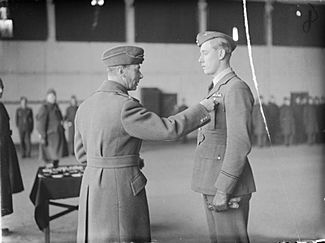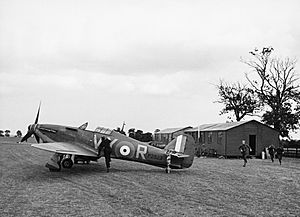Albert Gerald Lewis facts for kids
Quick facts for kids
Albert Gerald Lewis
|
|
|---|---|

King George VI conferring on Lewis a Bar to his DFC, c.1940
|
|
| Nickname(s) | Zulu |
| Born | 18 April 1918 Kimberley, South Africa |
| Died | 14 December 1982 (aged 64) |
| Allegiance | United Kingdom |
| Service/ |
Royal Air Force |
| Years of service | 1938–1946 |
| Rank | Squadron Leader |
| Unit | No. 249 Squadron No. 85 Squadron |
| Commands held | No. 261 Squadron |
| Battles/wars | Second World War |
| Awards | Distinguished Flying Cross & Bar |
| Other work | Farming |
Albert Gerald Lewis (born 1918, died 1982) was a brave South African fighter pilot during World War II. He was known as a "fighter ace" because he shot down many enemy planes. During the famous Battle of Britain, he even shot down five planes in one day! His amazing story was shared in Life magazine.
Contents
Early Life of Albert Lewis
Albert Lewis was born in Kimberley, South Africa, on April 10, 1918. He went to Kimberley Boys' High School when he was growing up.
Joining the Royal Air Force
When Albert was 20 years old, he joined the Royal Air Force (RAF). At the start of the war, he flew with No. 616 Squadron as a ferry pilot. This meant he flew planes to different locations. Later, he moved to No. 504 Squadron, where he flew Hurricane fighter planes.
In April 1940, he joined No. 85 Squadron in France. On May 19, he had an incredible day. He shot down five enemy aircraft! However, he was also shot down himself over a place called Lille.
In June 1940, Albert Lewis was given the Distinguished Flying Cross (DFC). This is a very important award for bravery in air combat.
Battle of Britain Heroics
On August 18, 1940, Lewis likely destroyed a German Bf 110 plane. On August 31, he probably destroyed another, a Bf 109.
Joining No. 249 Squadron
Albert Lewis joined No. 249 Squadron on September 15, 1940. On that very same day, he shot down a He 111 bomber. On September 18, he shot down a Bf 109, which was his twelfth confirmed enemy aircraft.
His most amazing day was September 27. He claimed to have shot down six enemy planes! These included three Bf 109s, two Bf 110s, and one Ju 88. He also damaged or probably destroyed three more.
The next day, September 28, Lewis was on patrol when his Hurricane was shot down. He had to parachute out of his plane over Faversham. He was taken to the hospital with serious injuries, including shrapnel in his legs and severe burns on his face, throat, hands, and legs. He was even blind for two weeks.
Return to Flying
Despite his injuries, Lewis returned to his squadron in December 1940. He had been promoted to flight lieutenant. By January 17, 1941, he was flying again and became the leader of "A" Flight. He was awarded a Bar to his DFC, which meant he received the DFC award a second time.
Overseas Service and Later Career
Albert Lewis volunteered to serve overseas. In January 1942, he was sent to No. 261 Squadron in Ceylon (now Sri Lanka) to take command.
After his overseas service, he returned to Britain. He became the Chief Flying Instructor at Tealing in Scotland. Later, from 1944 to 1945, he worked at No. 10 Group HQ. He left the Royal Air Force in 1946. By then, he was an acting squadron leader. In total, he had shot down 18 enemy planes during the war.
Life After the War
After the war, Albert Lewis studied at the Royal Agricultural College in England. In 1947, he returned to South Africa. Later, in 1951, he joined the Tobacco Research Board in Southern Rhodesia (now Zimbabwe). He also studied in the United States from 1953 to 1955. In 1957, he returned to England to become a farmer.


